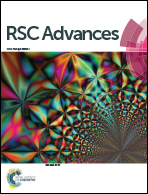Ferrocenyl based pyrazoline derivatives with vanillic core: synthesis and investigation of their biological properties†
Abstract
Vanillin O-alkylated derivatives and acetylferrocene reacted under Claisen–Schmidt conditions yielding the corresponding ferrocene containing chalcones in good-to-high yields. Under similar conditions, O-alkylated derivatives of acetovanillone were reacted with ferrocenylcarbaldehyde. Two series of novel N-acetyl and N-formyl pyrazoline derivatives were prepared by cyclocondensation of previously described chalcones (containing ferrocene framework and vanillic fragment) with hydrazine hydrate in acidic solvent (formic acid or acetic acid). All synthesized compounds were fully characterized by spectral and physical data and were tested for their biological activity. The antimicrobial activity was estimated by determination of the minimal inhibitory concentration using the broth microdilution method. The activity of the synthesized compounds was compared with standard antibiotics. The most active antibacterial compounds were 1-[5-(3,4-dimethoxyphenyl)-3-ferrocenyl-4,5-dihydro-1H-pyrazol-1-yl]ethanone (4a) and 1-[5-(4-benzyloxy-3-methoxyphenyl)-3-ferrocenyl-4,5-dihydro-1H-pyrazol-1-yl]ethanone (4f); the best antifungal activity was shown by compounds of type 4. The interaction of 4a, 4f, 5a and 5e with DNA and bovine serum albumin (BSA) were investigated by fluorescence spectroscopic method. The results achieved in competitive experiments with ethidium bromide (EB) indicated that 4a and 5e have larger affinity to displace EB from the EB–DNA complex than 4f and 5a, probably through intercalation. Fluorescence spectroscopy data show that the fluorescence quenching of BSA is a result of the formation of the 4a, 4f, 5a and 5e–BSA complex species. Measured values of Ka showed that compounds which contain the acetovanillone-formyl core (5a and 5e) formed more stable complexes with BSA than compounds with the vanillin-acetyl core (4a and 4f), suggesting that 4a– and 4f–BSA are less suitable for drug–cell interactions.


 Please wait while we load your content...
Please wait while we load your content...